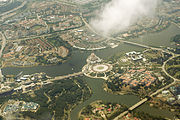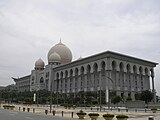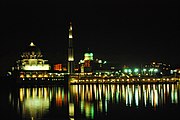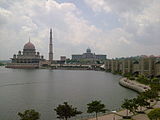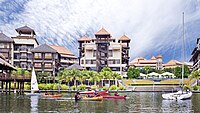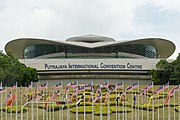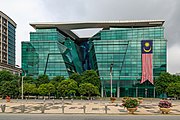
Kajang is a town in Hulu Langat District, Selangor, Malaysia, located southeast of Kuala Lumpur.
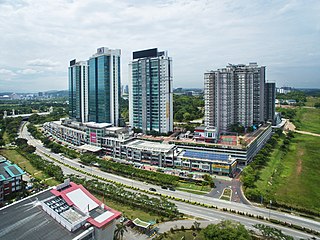
Cyberjaya is a city with a science park as its core that forms a key part of the Multimedia Super Corridor in Malaysia. It is located in Sepang District, Selangor. Cyberjaya is adjacent to and developed along with Putrajaya, Malaysia's government seat. This city aspires to be known as the Silicon Valley of Malaysia.

Kuala Lumpur Sentral Station is a transit-oriented development that houses the main railway station of Kuala Lumpur, the capital of Malaysia. Opened on 16 April 2001, KL Sentral replaced the old Kuala Lumpur railway station as the city's main intercity railway station. KL Sentral is the largest railway station in Malaysia, and also in Southeast Asia from 2001 to 2021, before Krung Thep Aphiwat Central Terminal in Bangkok, Thailand was completed.

The Sepang District is a district located in the southern part of the state of Selangor in Malaysia. Sepang District covers an area of around 600 square kilometres, and had a population of 190,889 in the 2010 Census.
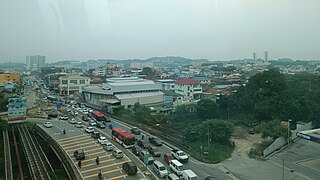
Seri Kembangan, also known as Serdang, formerly known as Serdang New Village, is a town located in Petaling District, Selangor, Malaysia. It is located in between Kuala Lumpur and Putrajaya. The town is now a considerable city in size. It is located near the northern end of the PLUS Expressway Southern Route North–South Expressway Southern Route.

Rapid KL is a public transportation system owned by Prasarana Malaysia and operated by its subsidiaries Rapid Rail and Rapid Bus. The acronym stands for Rangkaian Pengangkutan Integrasi Deras Kuala Lumpur, which translates to Kuala Lumpur Rapid Integrated Transport Network in the Malay language. Rapid KL, with its 204.1 km (126.8 mi) of metro railway and 5.6 km (3.5 mi) of BRT carriageway, is part of the Klang Valley Integrated Transit System, operating throughout Kuala Lumpur and Selangor's satellite cities in the Klang Valley area.

Putrajaya–Cyberjaya Expressway, Federal Route 29, is a major expressway in Klang Valley, Malaysia. The 21.2 km (13.2 mi) expressway connects Serdang interchange on Damansara–Puchong Expressway to Kuala Lumpur International Airport (KLIA) in Sepang. It was named after the two sides of the MSC cities, Putrajaya and Cyberjaya.
The Maju Expressway (MEX) (formerly known as Kuala Lumpur–Putrajaya Expressway(KLPE) and KL–KLIA Dedicated Expressway) Maju Expressway (Malay: Lebuhraya Kuala Lumpur-Putrajaya) is an expressway network in Klang Valley, Malaysia. The 26 km (16 mi)-long expressway links the Kuala Lumpur City Centre with the Kuala Lumpur International Airport (KLIA) in Sepang, Selangor. The expressway is a backbone of the Multimedia Super Corridor (MSC) area.

Puchong is a major town and a parliamentary constituency in Petaling District, Selangor, Malaysia.

Bandar Sri Damansara is a residential township in Petaling District, Selangor, Malaysia. The township is divided into two sections, SD1-SD5 in the north and SD7-SD15 in the south which are separated by Kuala Selangor-Kepong Highway. It is adjacent to Kepong and Sungai Buloh. The township consists of mixed development of commercial and residential properties. It was previously developed by Land and General Berhad and currently by TA Global.
Transport in Greater Kuala Lumpur includes a road network, a railway network, airports, and other modes of public transport. Greater Kuala Lumpur is conterminous with the Klang Valley, an urban conglomeration consisting of the city of Kuala Lumpur, as well as surrounding towns and cities in the state of Selangor. The Klang Valley has the country's largest airport, the Kuala Lumpur International Airport (KLIA), as well as the country's largest intermodal transport hub and railway station, Kuala Lumpur Sentral.

Putrajaya Sentral is a bus hub and a train station on the Express Rail Link (ERL) in Presint 7, Putrajaya, Malaysia. It is served by the ERL KLIA Transit Line under the name Putrajaya & Cyberjaya. On 16 March 2023, the MRT Putrajaya Line began operations under the name Putrajaya Sentral.

The Putrajaya Monorail is an incomplete monorail system in Putrajaya, Malaysia. Construction has been stalled since 2004, and while revivals have been proposed periodically, as of 2023 there are no plans to revive the project.

Bandar Saujana Putra is a township in Kuala Langat District, Selangor, Malaysia.

Perbadanan Putrajaya (PPj) or Putrajaya Corporation (PjC) is a local authority that administers the Federal Territory of Putrajaya and is under the Department of Federal Territories of Malaysia. Founded in 1995, the corporation is responsible for public health and sanitation, waste removal and management, capital planning, environmental protection and building control, social and economic development, and the general maintenance functions of the urban infrastructure of Putrajaya. The main headquarters of the PPj is located at Precinct 3, Persiaran Perdana, Putrajaya.
Pulau Meranti is a village in Sepang District, Selangor, Malaysia.

Bandar Putra Permai is a rapidly developing new town in Seri Kembangan, Petaling District, Selangor, Malaysia. It encompasses areas from Taman Desaminium, Taman Equine, Taman Dato' Demang, Taman Suria Tropika, Taman Lestari Permai, Taman Prima Tropika, Alam Sanctuary, Taman Lestari Perdana, Pinggiran Putra, Pusat Bandar Putra Permai, Kota Perdana, Puncak Jalil and Taman Lestari Putra. Bandar Putra Permai is located near Seri Kembangan, Putrajaya and Puchong. Most of the residents are originally of Chinese descent, but an increasing number of Malays live there.

Pengangkutan Awam Putrajaya Travel & Tours Sdn Bhd dba Nadi Putra is the city bus operator in Putrajaya, the administrative capital of Malaysia, mainly serving Putrajaya city and nearby resident areas. Originally established as an agency of Putrajaya Corporation under the Ministry of Federal Territories, it was privatised in 2018.

Taman Putra Perdana is a township in Dengkil sub-district, Sepang District, Selangor, Malaysia. Although the township's postcode is 47100 / 47120 / 47130, which gives it Puchong postal address, it is actually in the Sepang constituency of Selangor, administered by the Sepang Municipal Council (MPSepang). The township was developed by Kenshine Corporation in 1997.
The following is an alphabetical list of articles related to Selangor.


















